In a world where preparedness is key, versatile tools like WD-40 are essential for SHTF scenarios.
Since its conception in the 1950s by the Rocket Chemical Company, WD-40 has become a staple in homes, garages, and industries worldwide.
The formula, whose name stands for Water Displacement, 40th formula, was originally developed to protect the Atlas missile from rust and corrosion. Today, it serves myriad purposes.
In a SHTF scenario, unexpected and catastrophic events leave normal societal operations in tatters.
One of the keys to thriving in these challenging environments is versatility. The fewer items you need to carry, the more mobile and adaptable you are. This is where tools with multiple uses, like WD-40, become incredibly valuable.
As a survival expert, I’ve come to rely heavily on WD-40 in the face of adversity. Here are 15 ingenious ways you can use this seemingly mundane product to your advantage in SHTF scenarios:
Igniting a Fire
 Fire starting is essential for survival, and WD-40 can be a potent ally.
Fire starting is essential for survival, and WD-40 can be a potent ally.
It’s important to note that WD-40 is not inherently highly flammable but rather combustible.
While it won’t start a fire independently, it will make the process easier.
To start a fire using WD-40, grab a cotton ball or other combustible material and coat it with WD-40. Then, light it up using a lighter or match.
The flame will be large and sustained, allowing you to start the fire. This approach’s simplicity is one reason why WD-40 is so beloved in survival scenarios.
Repelling Insects
Insects like wasps, bees, or spiders tend to be deterred by the smell and oily barrier it creates, discouraging them from building nests or crawling on treated surfaces.
Related: 10 Insects You Should Never Kill On Your Property
To use WD-40 as a deterrent, simply spray it on areas where you’ve noticed unwanted insect activity. This could include door and window frames, corners, or other areas prone to nests or webs.
Removing Adhesive Residues
The solvents in the WD-40 formula are excellent at breaking down adhesives, making it perfect for removing stubborn residue left by tapes, stickers, or glues.
Spray a small amount onto the affected area, leave it for a minute, then wipe clean with a soft cloth. It works wonders on various surfaces, from glass to metal to plastic. This can be especially useful for repurposing containers or cleaning tools in a survival scenario.
Restoring Rusty Tools
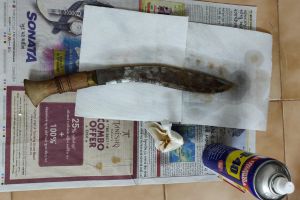 Rust can hinder even the most robust tools, making them useless when you need them the most. With WD-40, you can restore these tools back to their prime.
Rust can hinder even the most robust tools, making them useless when you need them the most. With WD-40, you can restore these tools back to their prime.
The product’s primary function is to displace water, preventing rust and hindering its formation.
To restore rusty tools, spray WD-40 generously on the rusted area and let it sit for a few minutes.
Then, scrub away the rust using a wire brush or abrasive pad. Finally, wipe the tool clean with a rag. This method can help preserve your tools, ensuring they’re ready to go when SHTF.
Protecting Electrical Equipment
One of the lesser-known yet critical uses of WD-40 is its role in protecting electrical equipment. The water-displacing properties that give WD-40 its name make it an excellent choice for keeping moisture away from sensitive electronics.
In a survival scenario, maintaining the function of radios, flashlights, or other crucial electronics can make a world of difference. To use WD-40 for this purpose, power off the device first.
Then, lightly spray the product on the exterior, avoiding any screens or openings. Wipe away any excess, leaving a thin film as a protective barrier against moisture.
Unjamming Stuck Parts
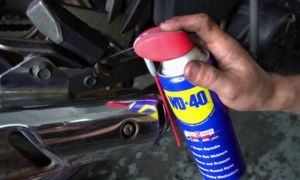 WD-40’s penetrating properties make it an exceptional ally in unjamming stuck parts, a common problem in survival situations.
WD-40’s penetrating properties make it an exceptional ally in unjamming stuck parts, a common problem in survival situations.
Its formula seeps into minute spaces, loosening tight spots and breaking the bonds of rust or corrosion.
Whether it’s a seized knife, a jammed lock, or a stubborn bolt, WD-40 can save the day. Spray WD-40 directly onto the stuck component, ensuring it infiltrates the problematic area. Let it sit for a few minutes to work its magic.
Related: 10 Medicinal Uses Of Alcohol You Can Benefit From Right Now
Then, attempt to gently move the part. For stubborn jams, additional applications and patience might be required. Having freely moving parts can significantly improve the function of your survival gear.
Rust Prevention
Rust can be a silent menace to your survival gear, undermining its efficiency when you need it the most. Fortunately, WD-40 serves as a formidable rust deterrent.
Its unique formula forms a protective shield on metal surfaces, locking out moisture – the root cause of rust. To prevent rust, spray a generous amount of WD-40 on the affected area and let it sit for a few minutes.
Then, wipe any excess with a clean cloth. Reapplication is recommended every month or so to maintain protection against rust. This can help preserve your essential equipment, ensuring optimal working conditions when SHTF.
Stuck Zipper Solution
 A stuck zipper can be incredibly frustrating.
A stuck zipper can be incredibly frustrating.
In a survival scenario, it can also hinder access to essential equipment or compromise protective clothing.
Fortunately, WD-40 comes to the rescue once again.
Its excellent penetrating properties make it perfect for lubricating and freeing stuck zippers.
A quick spray directly onto the zipper teeth, followed by gently working the slider up and down, can unstick the most stubborn zippers.
Whether it’s your tent, backpack, or survival suit, WD-40 can help ensure your zippers function smoothly when needed. Remember to wipe off any excess to avoid staining your gear.
Prevent Slugs and Snails From Eating Vegetables
Garden invaders like slugs and snails can harm your vegetable patch, particularly in survival scenarios where every crop counts. That’s why it’s crucial to know how to start a survival garden from scratch effectively.
An unlikely helper in this endeavor is WD-40. Rather than acting as a pesticide, it serves as a barrier creator. Spray a band of WD-40 around the containers or the base of planters prone to slug and snail invasions.
The slick surface deters these pests, preventing them from climbing and reaching your precious vegetables.
Remember to reapply after rain or regular watering. Be careful not to spray directly on the plants, as it may cause harm. With WD-40 serving as your garden’s first line of defense, your survival garden can flourish.
Splitting Firewood
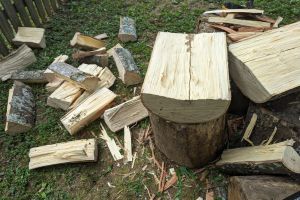 Splitting firewood becomes effortless with WD-40. Apply it on your maul or wedge’s blade before starting to chop.
Splitting firewood becomes effortless with WD-40. Apply it on your maul or wedge’s blade before starting to chop.
This creates a slick surface for smooth gliding through the wood.
Hold your tool’s blade away, spray WD-40, let it sit, then get splitting.
This small trick saves you time and energy in survival scenarios, making firewood preparation a breeze.
Improve Shovel Efficiency
A quick application of WD-40 creates a slick, non-stick layer on the shovel’s surface, making material slide off easily, reducing manual labor, and saving precious energy in survival situations.
To achieve this, clean your shovel first, then spray a generous coating of WD-40 over the entire blade surface. Let it dry before using.
Removing Stains From Fabrics
WD-40 is especially potent on old, oily stains, as the solvents within WD-40 break down the oil, detaching it from fabric fibers.
Simply spray a modest amount of WD-40 onto both sides of the stain, allowing it to work its magic for about five minutes.
Follow this with a wash using heavy-duty detergent in the warmest water recommended for the fabric. This unexpected use of WD-40 keeps you looking your best, even in challenging circumstances.
Waterproofing Shoes
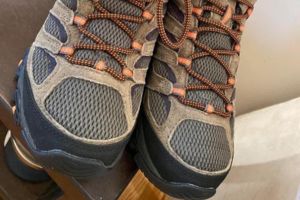 In a SHTF scenario, having dry feet can boost morale and keep you on the move.
In a SHTF scenario, having dry feet can boost morale and keep you on the move.
WD-40, your versatile survival aid, can step in as a short-term shoe waterproofing solution.
Its mechanism is simple; it forms a water-resisting shield on your footwear.
Here’s how to do it:
- Remove laces, insoles, and liners
- Brush off any dirt
- Take a clean cloth to evenly distribute WD-40 over your shoes
- Let it dry for a minimum of 30 minutes, and voila!
Remember, this isn’t a long-term fix; reapplication every few months is needed. Also, spot test to prevent material damage and expect a potential darkening of leather.
Defrosting Frozen Door Locks
In freezing conditions, door locks can ice over and become a frustrating barrier. Spray WD-40 directly into the lock mechanism, which can be done easily thanks to its straw applicator. After application, wait a few moments for the ice to thaw.
As a bonus, the WD-40 will also lubricate the lock for smoother operation. This trick is an essential nugget of wisdom for survivalists braving extreme cold weather conditions.
Eliminate Squeaks on Animal Traps
Squeaky hinges can alarm your prey, reducing your chances of a successful catch. By applying WD-40, you not only eliminate squeaks but also protect the trap from rust, prolonging its usability.
To do this, simply spray the hinges of the trap with WD-40 and let it seep into the mechanism for a few minutes.
WD-40 is an invaluable tool for survival situations, offering many applications beyond its well-known use as a lubricant.
From protecting electronic equipment and gardening to splitting firewood and removing stains, its versatility can significantly enhance self-reliance and efficiency in challenging circumstances.
Always keep a can within reach, and you’ll be prepared for whatever challenges come your way.
You may also like:
 Foods You Can Cook From Scraps You Normally Throw Away
Foods You Can Cook From Scraps You Normally Throw Away

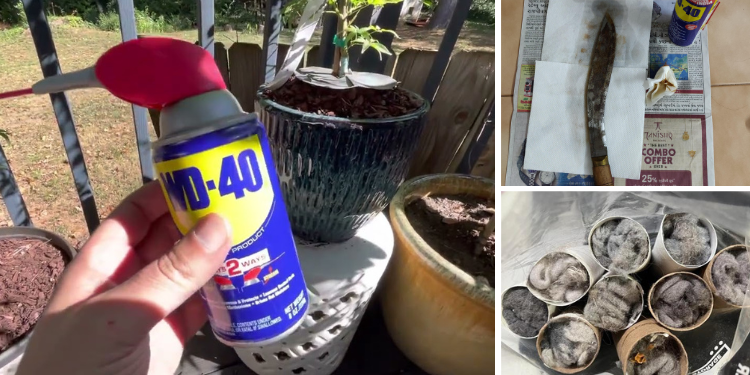













Yes wd40 has its uses. It was originally marketed as a water repellent. As far as a lubricant goes it sucks. Never use it to protect your guns or anything else from rust and crossion. I’ve worked as a consultant to investment bankers with a partner who was like a Mcguyver. I was introduced to those who actually made products that a small squirt from their product was enough to leave a thin barrier on your weapon and you could drop your weapon in the gulf of mexico and leave it there for 5 years, retrieve it, wipe it off, no rust, no crossion, and you would be ready to load and fire your weapon. Yeah. I purchased several cases of the stuff. Circa 2008 a can similar i. Size to wd40 of this stuff would run you about 19 dollars retail. When it comes to your weapons remember to use a lubricant. Not a water repellant like wd40
Can WD40 be used to blur the license plate numbers from police cameras?
There are sprays to blur license plate numbers from police cameras.
The sprays worked for the red light intersection cameras.
Too bad, in California in El Cajon and La Mesa cities have license plate reader and camera systems. Nothing here to see, move on citizen.
People have nothing to fear but these systems can be used for suspicious purposes. All the information is erased according to the police department. Sure we had heard that before and find out that is not true. The information is on government servers anyway.
The police say people are in favor of the cameras to reduce crime. The opposite is said these license plate readers are an invasion of privacy.
Taxpayers in other States need to keep an eye on California being a test bed for loss of American freedoms.
These activist and politicians are always finding ways to reduce our God given American rights in favor of government rights. The Deep State never sleeps for being a tyranny of America.
The ‘deep state’.
Someone spends too much time on the internet.
Macgyver is a anti-gun hero of the liberals.
‘MacGyver’ Star Not Proud of USA When It Comes to GunsBiden must be watching his hero’s TV series, as he supports gun control measures on honest citizens.
I figured he was anti-gun. It was revealed in how the show treated guns as a whole. He always disdained the use of them. However, it was my grandma’s favorite show back then, and there are other useful ideas (at least for kids) within the show besides their position on gun rights.
I was taught that he was the thinking mans hero. Improvise, create, remember that you may not always have a gun available. On top of that, guns have a limited calling. How are ya gonna use your rifle to get your truck out of the mud? What about building a shelter? How about building a canoe? Come on guys, THINK! Guns are not always the answer.
WD-40 is a mixture of solvents and libricants and while it may “suck” compared to purpose made firearms lubricants, in a SHTF situation it will do the job just fine.
The only reason we know of WD40, it was used to protect missile parts from corrosion in the Cold War. The workers took some home to use on their stuff. It was an amazing product that the company had many uses in the civilian world.
Definitely not for use on gun parts. There are long term side effects compared to the gun oils used to protect guns from corrosion. Do your own research.
WD40 IS 90% Kerosene. That’s why it’s not a good lubricant.
It sys it’s made of fish oil – the only ingredient.
David Smith, So are you at liberty to say what the other product is & if it’s available to the public?
Sure would be good to have a product like that before it vanishes with the rest of things that work & last a long time.
WD40 coming off the market in Canada… don’t know about the U.S.
Come Jan 1st, only 10% VOC (Volatile Organic Compounds) will be allowed for retail sale in Canada. WD40 has 25%.
Don’t spray it on your boots, degrades the glue and synthetic thread.
spray on enemy’s boots
WD-40 sprayed on chicken or other meat (while in a ziplock bag), makes great bait for fishing. Catfish love it.
The use of WD40 as bait might work, but eating a fish can be a mistake to being edible.
The only enemy is the administration here who thinks Republicans are pro gun
Had to cut off part of the grill of my 20 year old F150 because the latch was rusted shut. WD40 did the trick although the grill is compromised. Opens easy now.
If I remember correctly, WD in WD-40 stands for “Water Displacement” and it was originally intended to waterproof material but not in the typical fashion
Would NOT spray my boots with wd40.
There are plenty of other products that DO work for that
I live in the very wet Pacific Northwest. I now use WD40 to insulate the electrical connections of extension cords and terminal decor for yard decorations at Christmas time. I originally used black electrical tape on all connections. Mistake! That simply HELD the moisture in and I still had circuit breakers tripping. A guy at a hardware store mentioned that he uses Vaseline to do the job. Tried that and it worked fairly well, but Ohhhhh, the mess when you take it all down and need to store it away for the year.
WD40 sprayed in and on outdoor electrical connections, not only works better than tape or Vaseline (no tripped breakers) but it’s a lot less messy. Just keep an old towel with you as you take down your decorations. Simply wipe off. They will still retain some smell and slickness but nothing like tape goo or Vaseline.
We can spray WD40 at the Southern Border to repel the illegal invasion of Biden’s open arms policy. Hunter must be getting bribes from the pedophiles, rapist, satanist who all need sex slaves to replace their tortured victims in America.
We got hair sniffer Joe, what could Newsom and Michelle Obama be like?
Protect your children from these evil fiends.
Newsom was supposed to sign a bill on gender school rights. This takes parents right away so the woke teachers union can change your kids gender. The government thinks they own our kids, parents have no rights anymore.
For all of these applications, a much better choice would be silicon or graphite spray. I worked for the USPS for many years and the mechanics, who changed out locks on NBU’s (those cluster boxes in apartment buildings), would NOT use WD40, but rather one of the options mentioned as WD40 would eventually rust things. I follow his advice and use either silicon or graphite spray now.
Oh, and I would NEVER spray such a toxic product near my garden!!!!
WD-40 will scare away animals from your traps. Personal experience. If you grease them, use bacon grease. They love the smell of salt.